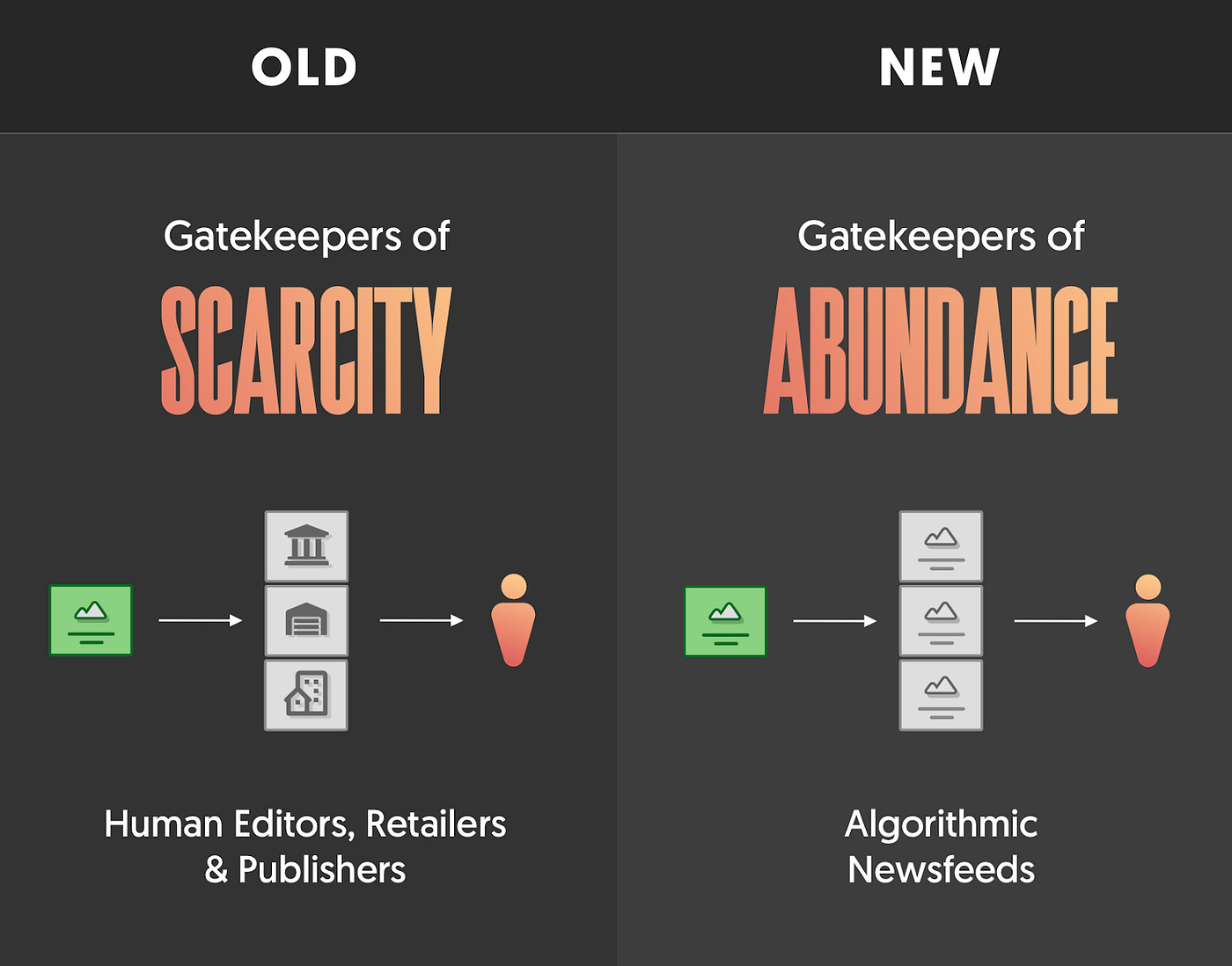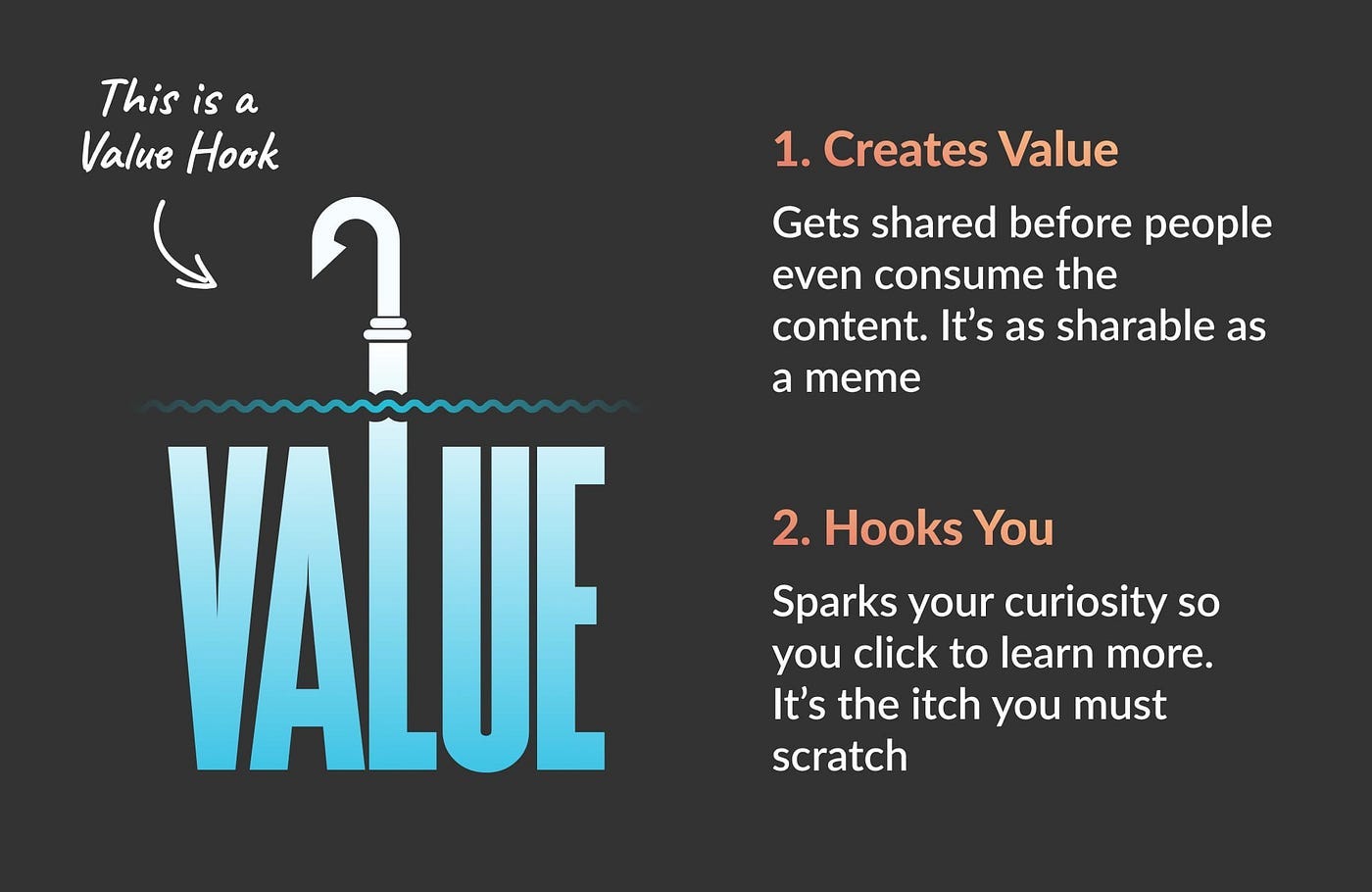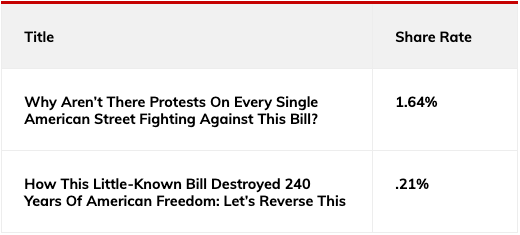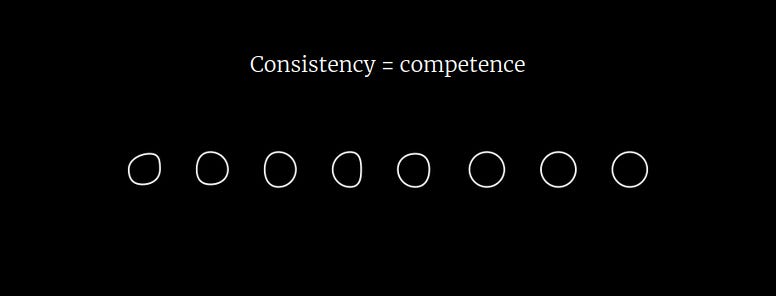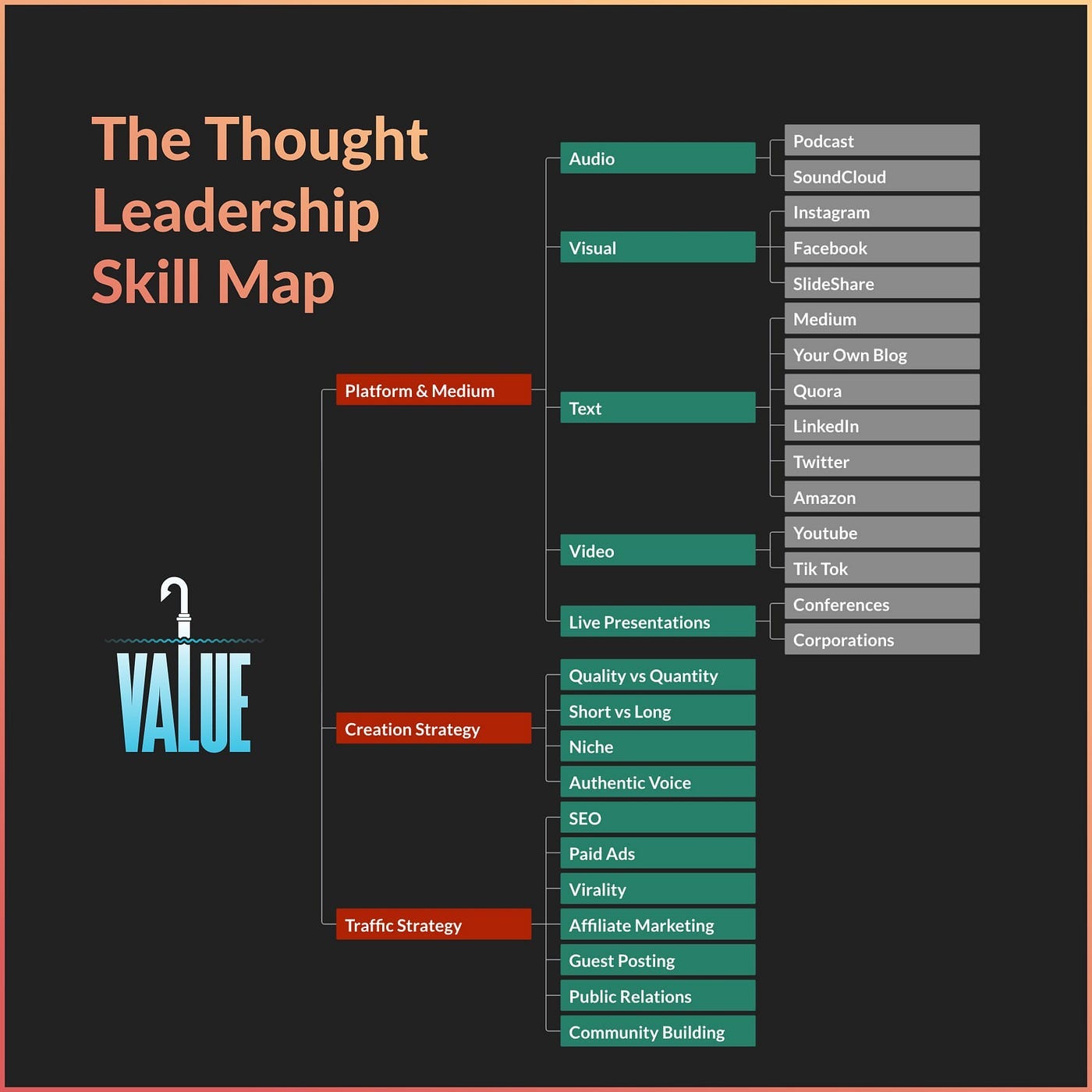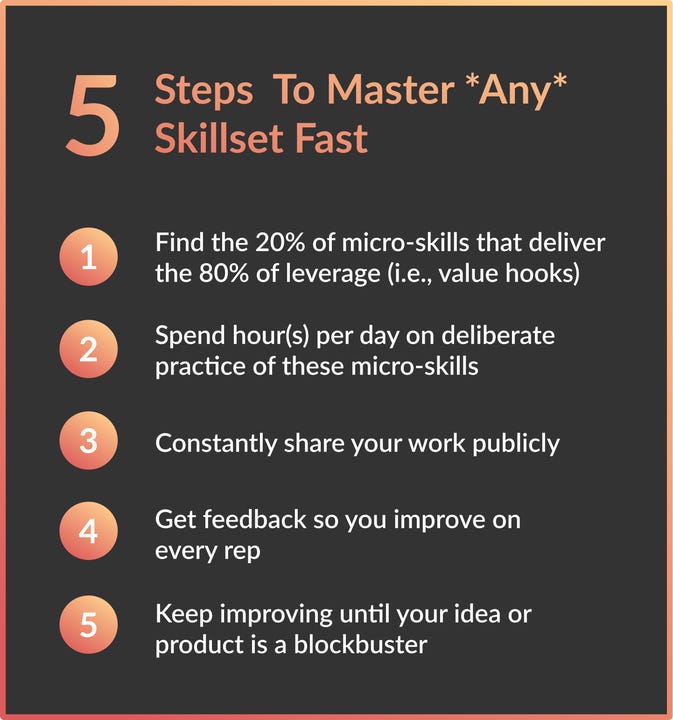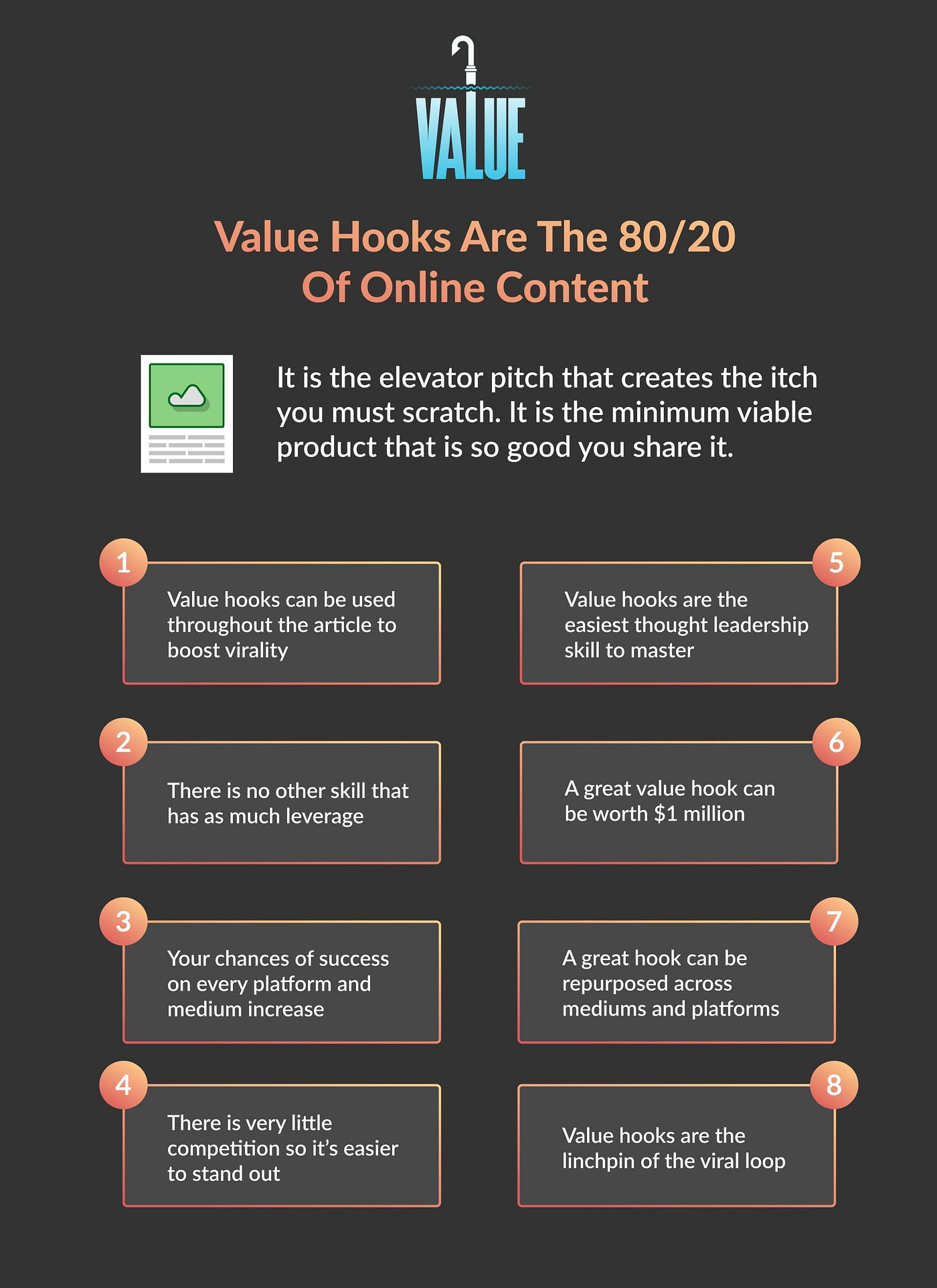Value Hooks: The #1 Skill Experts Need To Succeed Online (Based On Thousands Of Hours Of Research)
Personal Update: This post is a republish of an article I wrote in 2020, but the topic is even more relevant and important today.
To give context, over the last 10 years, I have spent many thousands of hours deliberately:
Identifying the highest leverage micro-skills to learn.
Identifying the topic experts in the world for those skills.
Studying the work of those experts and extracting patterns.
Performing thousands of tests on those patterns.
Applying the lessons to my own work and getting tens of millions of views and millions in revenue as a result.
Personally teaching the lessons to students in live cohorts and doing one-on-one coaching to help students get results.
After all of this, I created the most comprehensive skill map of thought leadership that has ever been created (to my knowledge):
And after all of those thousands of hours, I can confidently say that the #1 skill that takes the least amount of effort and provides the most return is what this article is about.
The #1 thing that stops experts from succeeding with writing online is creating hooks that get the reader to stop scrolling (email, search results, social media), get them to commit to reading the article, and get them to keep reading.
In other words, experts spend years understanding a topic and getting results. But, counterintuitively, this doesn’t make them succeed online. In fact, the opposite is true.
Going through the process of becoming an expert makes people worse online communicators in a few ways. Experts…
Have trouble empathizing with what it’s like being a beginner
Overuse jargon that confuse beginners
Think abstractly when beginners need concreteness
Forget key, granular details that have become so automatic and unconscious that they have forgotten about them
Overlook sharing key nuances that seem so obvious that they don’t tell others about them
Bottom line: To succeed as a thought leader, I am convinced that understanding value hooks is the #1 bottleneck for 99% of experts. This article, which I spent many months creating, will help you take a leap forward…
This article is like one of those movies that shows you the final scene first and then uses the rest of the movie to explain the ending.
So here’s the ending…
Reality is fed to us through a straw (algorithmic newsfeeds).
Newsfeeds consist of value hooks (title/image/subtitle).
Value hooks compete for our clicks and likes.
Winning value hooks get featured. Losing value hooks get buried.
Everyone can publish to the newsfeed.
Attention is finite and nonrenewable.
No one is in control.
Humans are chimps in disguise.
Mix all these together and what you have is a cold war for our attention between:
Businesses that want to get rich
Influencers who want to become famous
Experts who want to share their ideas
Politicians who want to get elected
Activists who want to change the world
Social networks who want to have the most engaging newsfeed
It’s a cold war because most people don’t even realize it’s happening.
Here’s what you need to know so you can be in full control of your life, career, and business, and get recognized for the expertise you have…
Attention is the frontline and leverage point:
Control your attention to control your destiny. Paraphrasing Lao Tzu: Control your attention to shape your thoughts. Control your thoughts to shape your actions. Control your actions to shape your habits. Control your habits to shape your character. Control your character to shape your destiny.
Shape attention to change the world. Attention is a necessary condition for social movements, political elections, diffusion of expertise, and marketing of innovations. Without it, important social issues move into the shadows, and the status quo is maintained. Expertise is locked in the heads of experts. Marketing for innovative products is dead on arrival. Therefore, have something worth saying. Learn how to shape attention. Use your power wisely.
Now that you know the ending, let me tell you about my story…
How I went from a published writer with no audience to a blockbuster writer with tens of millions of views
I became fascinated by attention because I knew two things for sure about it…
I did not understand it.
Not understanding it was killing my career.
I started writing in college. First, emails to my friends. Then articles in publications. Then a self-published book. And finally hundreds of blog posts. In the beginning, I imagined my writing going viral and being read by millions. In the end, I saw my words die in obscurity.
I stopped writing after college. That’s when I finally accepted that “if you build it they will come” was not working. It was also when I stared down $20,000 in credit card debt and tens of thousands in student loans and realized that I needed to make “live in the real world” money.
I didn’t pick up a pen again until eight years later. Eight years!!! That means eight years of not working on my ultimate passion because I didn’t understand attention. In retrospect, it’s painful to reflect on what those lost years cost me.
The second stage of my writing career began when my friend, John Hall, introduced me to an editor at Forbes, and I was invited to contribute.
At that point, I knew I was at a precipice between two worlds: the world of the PUBLISHED writer and the world of the BLOCKBUSTER writer. The published writer is able to say they’re a writer on their bio. The blockbuster writer is able to say their writing changes lives.

Being a published writer involves putting “good enough” words on a page and clicking publish. To be a blockbuster writer means investing years in skill development and quality so your content reaches millions of people and is so good that they share it with others, and it changes the way they act and think.
There is a large chasm between the two approaches because they require completely different strategies.
I decided to leap and attempt to be a blockbuster writer…
This decision changed my life
To make the leap, I had to confront two challenges…
I did not have a list
I had no budget to pay for the traffic
So virality was my only option if I wanted my writing to be read by millions and have an impact.
This is when my fascination with attention turned into active research.
When I first started, virality felt like this black box that was random and impossible to crack. I would see articles with thousands of shares and wonder how it was even possible. The idea that every new reader could result in more than one new reader felt magical.
Fortunately, early on, I received mentorship from a close friend, Emerson Spartz. Emerson had built a media company with billions of views, and he taught me the value of titles. He told me that they were the 80/20 of article writing. In other words, the 20% of effort that creates 80% of results.
At first, I was skeptical. “How could simply changing the title be that important?”
But, quickly, I saw the value first-hand when I applied what he taught me. Almost overnight, 5x more people were reading my articles.
This convinced me to double down. My team and I have now spent thousands of hours studying the patterns of virality, and we have A/B tested a whopping 4,000+ titles. To my knowledge, there is no individual or organization that has done this much studying and testing of article titles.
Now, the average article I write has 200,000+ views, and my writing has been read tens of millions of times and in publications like the Harvard Business Review, TIME, Forbes, and Fortune. Granted, we also improved at writing articles as well. But, we believe that a significant part of our success is due to titles.
Now I look at the virality process as systematic and replicable. In other words, virality can be consistently manufactured. Titles were only the first step.
In the rest of the article, I explain what I consider to be Archimedes' lever of attention online…
Millions publish every single day. How can you get noticed for your expertise?
You’re an expert. You want to share your ideas with the world. Now what?
Counterintuitively, it’s never been easier to share or harder to get noticed.
In the past, in order to publish a book, newspaper article, or magazine article, you had to convince a human editor. Now, you can publish without needing permission, but you must navigate past a new gatekeeper: the algorithmic newsfeed.
Whereas the old gatekeepers governed under a paradigm of scarcity (i.e., limited physical shelf space), the new gatekeeper governs under a paradigm of abundance (i.e., unlimited digital shelf space).
When the Internet revolution overthrew the monarchy of human editors who owned the printing presses, we thought we’d enter a democratic Internet utopia where everybody has a voice. But one gatekeeper has been replaced by another.
Ultimately, the problem for modern thought leaders comes down to this:
How do you stand out among billions of people publishing content via an algorithmic newsfeed?
The chart below captures the dilemma. First, the amount of content we humans collectively create online is doubling every year (also known as Zuckerberg’s Law). Second, the amount of attention we each give toward content is limited by the number of hours in the day. Together, these trends create hunger games where there is more and more content looking for the same amount of attention.

If you don’t have an answer to the attention hunger games, your ideas, which you’ve spent years researching, are dead on arrival.
Viral Content Vs. Content That’s “Dead On Arrival”: Most People Get It Wrong
Almost all online content is discovered in the same way… via a newsfeed.
The newsfeed is the modern store shelf.
In the offline world, people see your product’s packaging on a shelf with dozens of other packages…
In the digital world, people see your value hook in the context of a feed of 10+ other value hooks.
In other words, people log into Amazon, their podcast player, any social media site, their email, or Google, and they browse a scrollable list of newsfeed items.
Newsfeed items are standardized and always include a combination of 2–3 things…
… or something like this when they search Google.
I call this bundle the value hook.
The value hook is the elevator pitch of online content. It is the MVP (minimum viable product) for your blockbuster article. At its best, it does two things…
In other words, before readers even get to your content, you must win them over in the newsfeed. This is harder than it sounds. Social media newsfeeds are passive. Readers aren’t in a bookstore looking for a book. Rather, they’re in a line waiting to check out their groceries, and they’re bored.
Therefore, you must create an itch so strong that the reader MUST scratch it. You want them to feel like this…

And here’s how the simple math works:
If you’re not getting the results you want with content, it likely is because of your value hook.
The most common question people ask me is…
How can I promote my article?
The logic being:
When I normally publish, I don’t get much traffic.
So, the problem is traffic.
So, I need to promote the article to get more people to read it.
This is the wrong way to look at it.
Here’s the right way…
If you’re not getting the traffic you want, it’s probably because of your value hook.
When you truly land your value hook, people will share it for you as I explain in the following section…
The Psychology Of Value Hooks Revealed
The purpose of the value hook isn’t just to drive people to consume your long-form content. Hooks can stand alone and be commented on, shared, and liked on various social media platforms. Platforms like Twitter and Instagram are specifically designed for them.
Through A/B testing 4,000 titles on Facebook, I saw how changing the title alone could also change the percentage of people who shared the article. For example, back when I had a content agency, I saw how changing the following title changed the share rate by 8x. Keep in mind that both titles linked to the exact same content.
Then, I came across a fascinating study where a leading analytics company analyzed the reading and sharing behavior on billions of page views. The left quadrant in the chart below shows how most article sharing happens early in the article reading process, not after the person is done reading.
That’s when I realized, readers can’t be sharing the content—they haven’t even read it!—so what are they sharing? The value hook alone.
At first, I thought the idea of people sharing articles before they read them seemed irresponsible, but then I noticed myself doing it. For example, not too long ago, I caught myself retweeting this article before I read it…
After reflecting on it, I realized there were actually many reasons for me to share….
I thought it was interesting
It put something into words that I hadn’t before (joy of learning)
I trust Rhonda Patrick, and she was sharing an academic study
It relates to my niche of learning how to learn
It establishes me as an expert curator in my niche
It promotes my topic (benefits of learning)
The #1 Mistake Most Writers And Thought Leaders Make (No Matter What Industry)
If you’re wondering how to master the skill of creating a value hook, you’re already ahead of most people.
When it comes to creating blockbuster content, most creators make a predictable mistake in how they spend their time…
Most creators spend hours creating the content and minutes creating the value hook… even though the value hook is critical and what readers see first. This is why most creators hear crickets when they click “publish.”
The deeper problem is that people underestimate the sheer amount of competition and overestimate how good their idea is relative to others (like I did when I first started writing). The image below captures the mismatch...
Creating the idea first is putting the cart before the horse. It’s the equivalent of writing an entire book before writing a book proposal. You risk having a book editor come back to you and ask you to rewrite the whole book because they don’t like the hook.
RL Stine, one of the most popular book authors in history, takes it to the extreme…
I don’t even think about ideas anymore. I just think about titles.
—RL Stine
You may see a quote like this and think, “God, that’s depressing and makes for atrocious quality books.” But don’t tell that to my 9-year-old son who has read dozens of RL Stine books and watched all the related movies and TV shows.
Bottom line: If content is the king, the value hook is the queen.
Here are core reasons why I recommend delaying other thought leadership skills and focusing on value hooks first…
Why Mastering Value Hooks Is The Most Important Skill On The Internet (No Matter What Industry Or Niche)
Benefit #1: Value hooks can be used as memes throughout the article to increase virality
I started to realize the power of the value hook when I observed the sharing patterns of my articles. I noticed that when people shared them, they shared the link along with one of the many value hooks sprinkled throughout it. So in many ways, the value hooks were acting as memes.
More specifically, readers would share some combination of the following along with the link to the article:
Sub-header title
Favorite quote
Favorite image
After noticing this pattern, I started to design my articles differently. Rather than just viewing subheaders as ways to improve readability, I started to think of them as opportunities for value hooks. I also noticed other writer friends using this strategy successfully.
For example, in, These 20 Pictures Will Teach You More Than Reading 100 Books, my friend Benjamin Hardy, made an entire article out of value hooks. The article has now been viewed 1+ million times. Here’s an example of the sub-headers:
I was also inspired by Jack Butcher, creator of Visualize Value. Starting in January 2008, Jack started to create one value hook per day on Twitter. 18 months later, he was making more than $100,000 per month and reaching millions of people. Here is one of his most popular visuals.
These experiences and case studies showed me that combining quotes and visuals can create a synergistic effect where 1+1 = 10.
To see the multiplicative power of quote visuals for yourself, take one of history’s most powerful symbols—the yin-yang symbol. Notice how quotes multiply and augment the value of the symbol.
As you can see, any quote can have multiple visuals. And any visual can have multiple quotes.
When you use a viral quote and image, you get to skip trial & error and use something that has proven itself over and over for hundreds of years.
The next sub-category of value hooks is coining your own word or phrase (what I call a trademark idea). I learned about the value of trademark ideas from my mentor and friend, Eben Pagan. Eben has literally coined hundreds of new words and many of them have become cornerstones in the Internet marketing world.
Eben helped me see that trademark ideas are the ultimate 80/20 because when you create a trademark idea that other people find so valuable that they use it in everyday conversation and write articles about it, you reach a whole other level of virality, reputation, and impact. I’ve now coined dozens of words that have resulted in thousands of articles, talks, and videos where other people mention them.
You create a trademark idea by identifying areas where a word should exist but doesn’t yet. Value hook is an example of such a word. For years, my team and I have been struggling for a word that describes the title, image, and subtitle. We alternated between calling the whole bundle a title and saying each word.
To get an idea of how everything fits together, here is a visual I recently co-created that went viral on its own and also supported an article I wrote. It is a combination of a title, a trademark idea (4D thinking), and a visual.

This unique visual and idea of 4D thinking are assets I can reuse across social media platforms, in articles, in classes, and even as a b-roll in a video.
Before understanding the standalone power of value hooks, I used to be a “length” elitist. I used to feel that articles under 1,000 words were not real blockbusters. Over time, I’ve learned that what value hooks give up in nuance and depth, they make up for in virality, speed of comprehension and creation, and stickiness.
For example, the best quotes or images can last for thousands of years. They can literally turn into art people hang on their walls or use as wallpaper for their desktops.
So my new mantra is…
Old: “A picture is worth a thousand words”
New: “A value hook is worth a thousand books.”
Benefit #2: There is no other skill that has as much leverage
The value hook is Archimedes’ lever of creating content in an online environment. It is where the smallest amount of effort can pack as much punch as an entire article.
Want to reach millions of people?
Master value hooks.
Want to build a multi-million dollar advertising campaign?
Master value hooks.
Want to do less and get more done?
Master value hooks.
Benefit #3: Your chances of success on every platform and medium increase
You may say, ‘My God, this is already getting way too tough.’ But, fortunately, it isn’t that tough, because 80 or 90 important models will carry about 90% of the freight in making you a worldly-wise person. And, of those, only a mere handful really carry very heavy freight.
— Charlie Munger
Because of this quote, whenever I enter a new domain that feels overwhelming, I look for the few fundamental skills that have the highest leverage. Then, I master them first. This is how I came across the hidden power of value hooks.
Navigating all the options for being a thought leader can be overwhelming… especially in the beginning. There are literally hundreds of experts touting dozens of strategies, platforms, and mediums and explaining why their specific approach is the best. Who do you trust? What if you take the wrong path?
I’ve seen many would-be thought leaders never get started because of overwhelm. I call this the thought leadership maze of hell.
The value hook simplifies the whole maze. No matter what path you take, improving your value hooks will help you be more successful. No matter what platform. No matter what strategy.
Value hooks are the reading, writing, and arithmetic of thought leadership in that it is useful no matter what path you take. It is the “wax on, wax off” of content creation.
For example…
Videos on YouTube need an incredible thumbnail and title.
Paid ads need a clickable hook.
Podcast titles and thumbnails need to stand out.
Amazon books need a killer title and book cover.
Email marketing/prospecting needs great subject lines.
In addition, whether you’re guest posting, launching a PR campaign, trying to go viral, building a community, or optimizing for SEO, value hooks will help.
Benefit #4: There is very little competition so it’s easier to stand out
Given how important the value hook is, you would think that everyone would be studying it. You would think there would be courses up the wazoo on it.
If you assumed this, you would be wrong.
Almost no thought leaders think of value hooks as a skill, let alone study, practice, and test them.
Benefit #5: Value hooks are the easiest thought leadership skill to master
After years of studying and teaching the topic of learning how to learn, I’ve learned how to learn faster and better from academic research and learning luminaries like Elon Musk, Bill Gates, Jeff Bezos, Oprah, and Warren Buffett. This image simplifies one of my biggest lessons learned…
Creating value hooks is the 80/20 micro-skill, and it also happens to be the easiest part of thought leadership to apply deliberate practice to because…
There are fewer skills required to master value hooks than to create blockbuster content. Therefore, it’s easier to get more reps on those skills because they’re short and simple.
It is 10x cheaper and faster to test value hooks than content. Testing gives you immediate and objective feedback, which helps you improve faster.
There are proprietary data sources (more on this later) of hundreds of millions of titles you can access that allow you to quickly learn from the best titles in the world.
In 5 hours, you can easily double your ability to create value hooks. It could take dozens or even hundreds of hours to improve to the same amount as a writer.
Benefit #6: Just one great value hook can be worth $1 million
How could a few simple words and an image account be worth $1 million dollars?
Over the years, I’ve seen this first-hand on multiple levels…
SEO: The clickthrough rate impacts your search engine ranking.
Paid ads: The clickthrough rate dramatically reduces the cost per click.
Community: More engagement means more community involvement.
Guest Posting: The first filter editors have is the value hook.
Here’s a recent example of how one of our value hooks transformed our paid marketing campaign. We took an existing hook and just changed the image. We immediately saw a 33% drop in the cost per click and an increase in conversion, which led to a 60% increase in Return On Ad Spend.
Think about how crazy that is. Finding this one image will make us hundreds of thousands of dollars in profit in the coming year. One image! It doesn’t get higher leverage than that.
The following hook laid the foundation for hundreds of millions of dollars in revenue for Craig Clemens’ Golden Hippo…
In addition, value hooks set the frame. And whoever sets the frame, wins the game.
For example, if I say, “Look at that tree. Isn’t it beautiful?” I’ve gotten you to do two things:
Look at the tree
Judge it by its beauty
So even if you feel that the tree isn’t beautiful, I’ve gotten you to take your attention away from the millions of other things you could’ve focused on and gotten you to judge the tree by its beauty. More so, I’ve influenced you on a fundamental level without you even realizing it.
As an example of the power of framing, Amazon recently acquired a self-driving car startup in its quest to challenge Tesla in the self-driving vehicle market. Soon after Amazon made the announcement, Elon Musk tweeted the following…
Now there are dozens of mainstream media outlets posting articles about whether or not Amazon is a copycat rather than writing articles about how the acquisition will help Amazon compete with Tesla. Musk masterfully influenced the frame, and most people think he just posted a cute cat emoji as a joke.
Whether you agree with Musk or not, doesn’t matter. He has set the frame. And that frame influences what people write about. And coincidentally (or maybe not), just 10 hours before Musk tweeted this…
Bottom line: You may not realize it, but you’re only one good hook away from going to the next level in your business, scaling your message to millions of people, and generating millions in revenue over time.
Benefit #7: A great hook can 10x your reach via repurposing
For one hook I created, two book agents reached out to me and asked me about developing the hook into a book.
In addition, several of my articles have been turned into videos by others, and those have spread to millions. Below are the YouTube search results for the 5-hour rule, a term I coined:
Notice how these three search results add up to over 4 million views! The hook works across platforms.
In addition, when I have a hit article, I typically syndicate it across 5–10 platforms. Those platforms then promote it heavily because it performs so well.
Bottom line: Once you have a hook, you can also reuse it over and over.
Benefit #8: Value hooks are the linchpin of the viral loop
One way to think about the Internet is as a giant Matthew Effect—the rich get richer and the poor get poorer.
When you have a world-class value hook, the Matthew Effect works for you rather than against you.
First, social media sites show you love.
All our newsfeeds are algorithmic now. So when you log into social media, you don’t see all the posts of everyone you follow. You only see a tiny fraction of them… the ones the algorithm has selected. Given that social media sites are in the business of selling ads, they feature content that people engage with and bury non-engaging content.
A 1% engagement rate is not engaging. This means it gets buried even more! And this makes sense from the perspective of these social media companies. If they show you ten newsfeed stories every time you log in, and you only engage with 1% of them, that means you only find something interesting 1 out of 10 times you visit the site. Visitors won’t come back with numbers like that.
On the other hand, if you have a title with a 10% click-through rate, you will be showered with love from social media sites. This means you might actually get 20 times more views because of the algorithm boost.
Second, virality compounds the value of your value hook.
After a reader shares your article, the first thing their friends see is your value hook. Then the first thing your friends’ friends see is your value hook. Your value hook gets reused over and over.
Third, online writers are constantly looking for things to write about.
If you have an amazing value hook, they will use the hook to create their own content. For example, after I coined the 5-Hour Rule value hook, thousands of people used it in their own content.
Fourth, aggregators are constantly looking for content to curate
There are more and more sites and apps dedicated to curating and promoting the best content online. These tools range from Apple News and Morning Brew to Pocket.
Now you see what I see. You see the amazing power that comes from value hooks:
So how do you move forward from here?
At the beginning of the article, I mentioned how I was on a precipice between being a Published Writer and a Blockbuster Writer, and how I made the leap.
I invite you to make the same leap if you haven’t already…
There are just two steps you need to take.
First, commit to mastering value hooks.
Second, commit to creating blockbuster content. For every article you write, aim to write the best article that has ever been written on that topic. As I explain, Blockbuster: The #1 Mental Model For Writers Who Want To Create High-Quality, Viral Content this approach will boost your virality and make a huge impact, which will help you build a business from articles.
The magic happens when you combine blockbuster content and value hooks. Having an incredible value hook with mediocre content will just train people to ignore you.
3 Simple Steps To Improve At Hooks (paid subscribers)
Over my years of practicing and teaching hooks, I’ve learned that the below steps are easiest to do and most powerful to do consistently...





